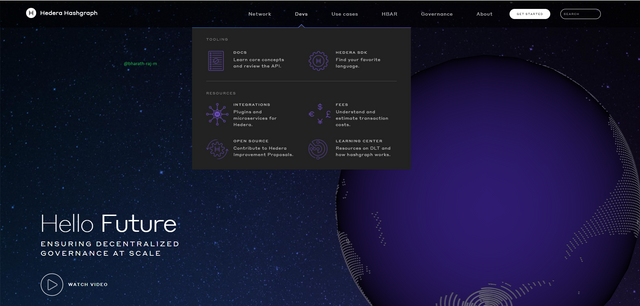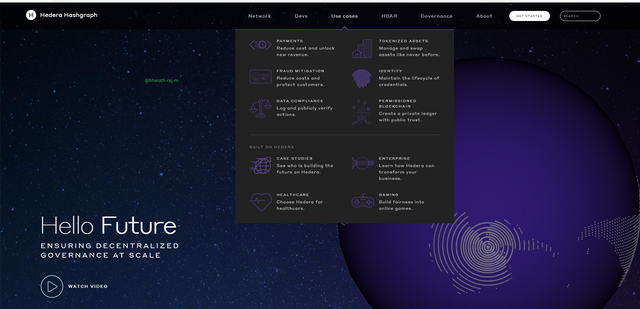Steemit Crypto Academy Season 2: Week8 | HASHGRAPH TECHNOLOGY, by @ pelon53
1.- Explain in detail the Gossip protocol, used in Hashgraph.Basically, Hashgraph is nothing more than new technology, a decentralized database, in which the information is not in a single Server, that is, it is distributed in several nodes of the network, decentralized, but Patented that offers security and information distribution, capable of processing thousands of transactions per second. And although on paper it sounds very good, we will have to see how it develops in practice, Hashgraph was released by Leemon Baird in 2018, who presented the project very similar to the Blockchain, but much more decentralized, and with greater scalability.
The use of the Gossip Protocol tremendously improves transaction speed.
Utilizing the gossip protocol, processing of information simultaneously by several nodes improves scalability on the Hashgraph network as it can allow up to 10,000 Transactions Per Second(TPS).
The Random Nature of the Gossip Protocol ensures that if there is a hindrance of a transaction in a certain path, information can flow through different nodes to reach their destination. This makes the Hashgraph fair.
Since different nodes work on their own, there is no appreciable information transfer and thus reduces the congestion of information over the network
Hashgraph is a technology or we can say an alternative to blockchain. It is a decentralized technology. It is a greater competitor of blockchain to maintain or achieve this level of competitor. Hashgraph promises us the high security and high performance. This system also solves the problem of scalability. This hashgraph is based on Direct Acyclic Graphics (DAG). Hashgraph also uses virtual voting things which are supported by Gossip Protocol. Now let's discuss more the Gossip Protocol in details
Gossip Protocol is basically a data transmission system just because of this data transmission thing the hashgraph work becomes very efficient and secure. The scalability also trying to reach 1000 per second. Though the features are still in progress but all this depends upon the Gossip Protocol.
I would like to explain a little more how important the Gossip protocol is.
The ability to process 250,000 transactions per second. When we consider that the Bitcoin blockchain can process 3-7 transactions per second, we can understand how impressive this protocol is.
We know that there are conflicts between groups in blockchains at certain times. In this case, a hard fork is inevitable. It does not exist here and is Byzantine Error Sensitive.
It is not affected by malicious attacks such as Sybil and DDOS.
So, they sene information between network nodes and then do transactions. There is also a concept of Gossip about gossip for example when C makes transactions with E then C will tell E about their present node i.e. A. So, when C is telling E about A this is called Gossip gossip. In this case, each and every member should have all the copies of the previous hashgraph with them for continuing the previous information to a new member in the chain. This hashgraph record shows all history of transaction which were recorded when gossip takes place in the large amount. Hashgraph usually has a change in it but its remain constant for the old member like A and C that transaction will always be constant for them.
2.- Explain Byzantine Fault Tolerance in Hashgraph..One of the important aspects of hashgraph technology is that it is sensitive to Byzantine error. A situation in which all members of a group or a network must agree on any or all strategies. When the community cannot reach a consensus, a fork does not necessarily arise.
Hashgraph is Asynchronous Byzantine Faults Tolerant which essentially implies exchanges are possibly approved when hubs in an appropriated network arrive at an agreement and as such can be numerically demonstrated that the exchange approval would happen. A couple of things to note in Asynchronous Byzantine Faults Tolerant are recorded underneath.
To validate a transaction there has to be a minimum of 2/3 reaching a consensus. There should be less than 1/3 malicious nodes detected. It also ensures that once consensus is reached, it can not be reversed and therefore the transaction can not be reversed.
It has high Fault Tolerance since it does not alter the system the faults presented by any node, since they have the same function and work the same, and the faults will not affect the message route.
On the other hand, its high Gossip scalability allows information to be sent much faster than in the case of blockchain, and it is received and processed more efficiently.
The Gossip protocol operates in two different ways, one of them is the Broadcast Protocol where the nodes share the information without alteration, and in it, the nodes do not have a start indicator to send the information.
And on the other hand, in the aggregation protocol here the nodes save the information received, and send a summary of this to the other nodes, maintaining constant activity which makes the network always updated and has detailed information.
Byzantium Fault Tolerance needs to ask for proof when no solution is reached.
Against the possibility of erroneous, incomplete information recording in hashgraph technology, all groups in the network reach a consensus by means of a previously applied method. Bitcoin uses the Proof-of-Work consensus algorithm for Byzantine Fault Tolerance.
Confirmation of transactions on the network depends on the 2/3 majority. No problem will arise unless the number of malicious users or transactions exceeds 1/3.
3.- Make a comparison between Hashgraph Vs Blockchain, for a voting process in your country. Which technology would you choose? Why?Blockchain
- Blockchain is a system in which blocks are connected one by one it is Incurptable it makes exchange and transaction among many users online. All transaction is arranged and protected by high security. All new blocks made connected with the chain by new blocks i.e. why they are called Blockchain.
Hashgraph
- Hashgraph on the other hand uses virtual voting and gossip as an approach to reach consensus, Hashgraph is also a decentralized technology that is based upon DAG. This is a basic voting algorithm which is connected through the gossip protocol which makes all the transaction Efficient, Fast, Secure. All transaction information is known by all the users. Then on the data of hashes got a vote on all hashes then only that data consider as 100% valid i.e. why it is more secure and provide strong Byzantine Fault Tolerance.
On the basis of the programming language they’re written, the two differ. Whereas Blockchain is written with different programming languages
Hashgraph is written in Java and Lisp programming languages
In Blockchain the security mechanisms are based on a cryptographic hash
AND in Hashgraph as we have already seen Asynchronous ToleranceOn the other hand, Blockchain has its Scalability problem, while Hashgraph has the ability to handle all the Information and also without delaying it.
Hashgraph uses Asynchronous Byzantine Tolerance to ensure the security of the network
Blockchain uses cryptographic methods to ensure security on its network by voiding data signatures once data is tempered
Blockchain is public to all person means all databases will be in front of all users and anybody can access it easily.
Hashgraph is private, it carries node to node information or data, and each node is trusted and data of each node can't be share to outsider
Blockchain speed is lower than Hashgraph. Blockchain needs to verify their client whereas Hashgraph is pre-verified clients.
Blockchain technology is more popular nowadays. Therefore, people are more knowledgeable about blockchain technology.
Hashgraph technology is not well known yet. Therefore, it is difficult to foresee possible problems.
Which technology would you choose? Why?In India, I would like to prefer the Hashgraph voting system because this system is more secure. It is based upon transmitting the data nodes to nodes. Hashgraph voting system is better because in countries like India which is democratic and everybody has the right to vote and wants fair results they require a strong, Elections are held in democratic countries. It wants voters to complete the election process in a fair, transparent, fast, and safe manner.
Hashgraph technology is very secure. We know that it is protected against attacks such as DDoS and Sybil. It is very important that the election process cannot be sabotaged by attacks.
Voters want elections to take place quickly. We know how fast hashgraph technology is when it comes to speed and scalability.
So to remove this consequence Hashgraph system can provide a voting system from which a person can vote instantly without the fear of plagiarism in the counting system.
4.- Make a comparison between Hashgraph Vs Blockchain, for a voting process in your country. Which technology would you choose? Why?- To explore Hedera Hashgraph, I first visit hedera.com and this is what the homepage looks like as shown in the below image
- All information about the Network and Developers this is the first option as shown in the below image.
In this section, there are consensus options for local tokenization and any application without a smart contract. It is mentioned that local tokenization without smart contracts in their own networks is very effective. Apart from that, they argue that they are quite costly. They mention that they have advantages such as privacy, low cost, and flexibility in their transactions for any application.
In the "How it works" section you can test how a new application is created and how it works with the hashgraph.
In the "Network explorers" section, you can find all the details about the hedera main network and testnet graphic network.
It is possible to access all statistics regarding transactions in the "Dashboard" section. You can learn the transaction volumes in the network in hourly, daily, weekly and monthly periods.
- On the homepage, we can see the 3D globe with locations of some places on it and the blinking spot or the location marks.
- next to the network option is Dev and in the Devs category Docs, Hedera SDK, Hedera Plugins and Microservice, Fees
Docs: You can learn more about the Hedera Hashgraph here and give feedback and suggestions to improve.
Hedera SDK: over here you can find your favorite languages as well as some of the community-supported development tools
Hedera Plugins and Microservice: You can integrate your already existing application with the hedera network with the help of plugins and microservice
Fees: This shows fee schedules in USD set by the governing council.
When you click on the Open source section, you can see the codes on the network and see the updates with the network. You will be redirected to the Github site to view all updates.
You can see the institutions and organizations they cooperate with within the Learning Center section.
- next to Dev option there is USE CASE Some interesting menu under this option like Payment, Permissioned .
In Payment, You can information on how to use the Hbar, Hadera's currency, or your own cryptocurrency.
Permissioned Blockchain We can learn how to control information shared with a group of people here.
- HBAR this is the fourth option on the home page Obviously you also have information about your HBAR Token, your detailed information, the portal where to create an Inherit account, and the direct Wallet to use HBAR this is the fourth option on the home page.
HBAR section has Overview, Account Creation, Wallets & Exchanges sections.
Information about how fast transactions are in the overview section. Information stating that we can instantly create a new Hedera network with 3rd party wallet providers in the account creation section. Information on wallets and exchanges that support Hedera in the Wallets & Exchanges section.
- Governance this is the fifth option on the home page,
In the Governance section, there is information about Hedera management and the various entrepreneurs and organizations they cooperate with. They have a total of 39 collaborators from 11 different sectors.
- on the home page the sixth option is About, And they let us know the work team, which is made up of 16 renowned Developers, as well as the investors that the project has.
They consist of a very impressive and successful team. There are 16 people on the team. Hedera Hashgraph's Founder and chief scientist, Dr. Leemon Baird is the founder and CEO of Mance Harmon. You can click on the part that says "Bio" to learn about the people in the team.
BTC processes +3 transactions per second, ETH +12 transactions per second Hedera Hashgraph processes more than 10,000 transactions per second. The gas fee is $ 22.57 in Bitcoin, $ 19.55 in ETH, and $ 0.0001 in Hedera. The transfer time is 10-60 minutes in BTC, 10-20 seconds in Ethereum, and 3-5 seconds in Hedera.









Hello steemians please review your tags and make amendments thank you.
Gracias por participar en Steemit Crypto Academy:
Faltaron las conclusiones finales. Hay que justificar el texto. No le colocaste el nombre de usuario a las captures de pantalla.
Espero seguir leyendo tus publicaciones.
Calificación: 8.2